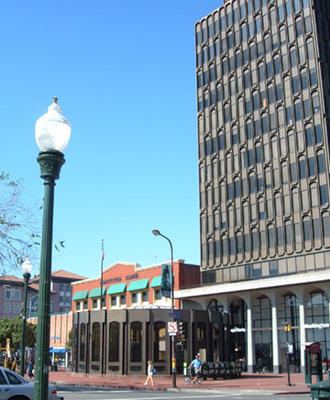The Berkeley BART Drum
There is talk about replacing the round entryway over the entrance to the downtown Berkeley BART station, called the BART drum, so I have been mulling over why I have always disliked the BART drum. I think I have figured out the symbolism that is involved.
In the early 1970s, I was a great admirer of the Bay Guardian and its crusade against high-rises. During the 1960s, the Guardian had also crusaded against BART, saying that it was part of a plan to bring in the commuters needed to turn the Bay Area into the corporate center of the emerging Pacific Rim economy. (I disagree with their opposition to BART, but I agree with their opposition to corporate globalization.)
The ABAG regional plan of the 1960s talked about BART bringing commuters into the "San Francisco-Oakland-Berkeley core" of the Bay Area. In the dominant vision of that time, the Great Western Building (now the PowerBar Building) would be the first of many highrises that would transform downtown Berkeley into a part of the Bay Area's corporate center.
The design of the BART drum symbolized this vision of Berkeley's future. It was designed in the steel-and-glass modernist style that generally symbolized corporate architecture, and the colors of the steel and glass were chosen to match the Great Western Building next to it, the first building in Berkeley's new wave of corporate high-rises.
Needless to say, this vision of downtown Berkeley's future is obsolete. At the time, they were still thinking in terms of an old-fashioned urban core, and they were not thinking about the rise of Silicon Valley or of business parks in San Ramon and other edge cities.
Now, everyone realizes that downtown will not be a regional corporate headquarters, and that its success depends on attracting arts, political groups, and housing, as well as business -- drawing on Berkeley's historical role as a regional intellectual center.
That is why many people are now backing the idea of replacing the drum, designed to symbolize corporate modernism, with a structure designed to symbolize Berkeley's history and future as a cultural and political center of the Bay Area.
In the early 1970s, I was a great admirer of the Bay Guardian and its crusade against high-rises. During the 1960s, the Guardian had also crusaded against BART, saying that it was part of a plan to bring in the commuters needed to turn the Bay Area into the corporate center of the emerging Pacific Rim economy. (I disagree with their opposition to BART, but I agree with their opposition to corporate globalization.)
The ABAG regional plan of the 1960s talked about BART bringing commuters into the "San Francisco-Oakland-Berkeley core" of the Bay Area. In the dominant vision of that time, the Great Western Building (now the PowerBar Building) would be the first of many highrises that would transform downtown Berkeley into a part of the Bay Area's corporate center.
The design of the BART drum symbolized this vision of Berkeley's future. It was designed in the steel-and-glass modernist style that generally symbolized corporate architecture, and the colors of the steel and glass were chosen to match the Great Western Building next to it, the first building in Berkeley's new wave of corporate high-rises.
Needless to say, this vision of downtown Berkeley's future is obsolete. At the time, they were still thinking in terms of an old-fashioned urban core, and they were not thinking about the rise of Silicon Valley or of business parks in San Ramon and other edge cities.
Now, everyone realizes that downtown will not be a regional corporate headquarters, and that its success depends on attracting arts, political groups, and housing, as well as business -- drawing on Berkeley's historical role as a regional intellectual center.
That is why many people are now backing the idea of replacing the drum, designed to symbolize corporate modernism, with a structure designed to symbolize Berkeley's history and future as a cultural and political center of the Bay Area.
 The BART Drum (lower center) and Great Western Building (right) clash with the traditional architecture of downtown Berkeley and with the historic streetlights installed recently to help revive downtown.
The BART Drum (lower center) and Great Western Building (right) clash with the traditional architecture of downtown Berkeley and with the historic streetlights installed recently to help revive downtown.

0 Comments:
Post a Comment
<< Home